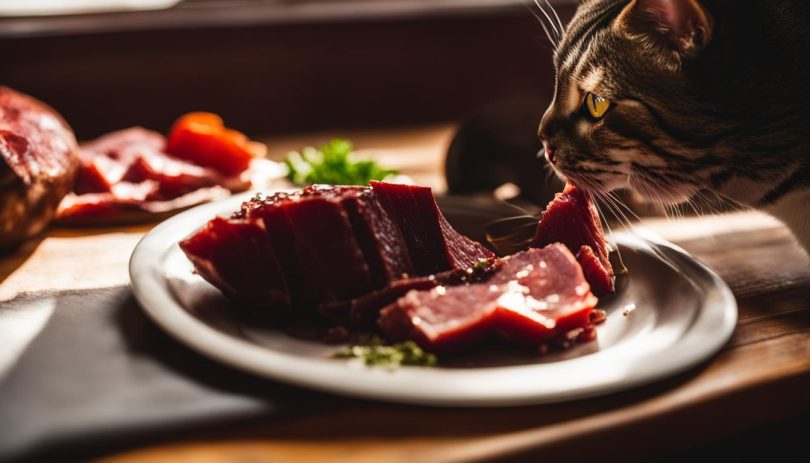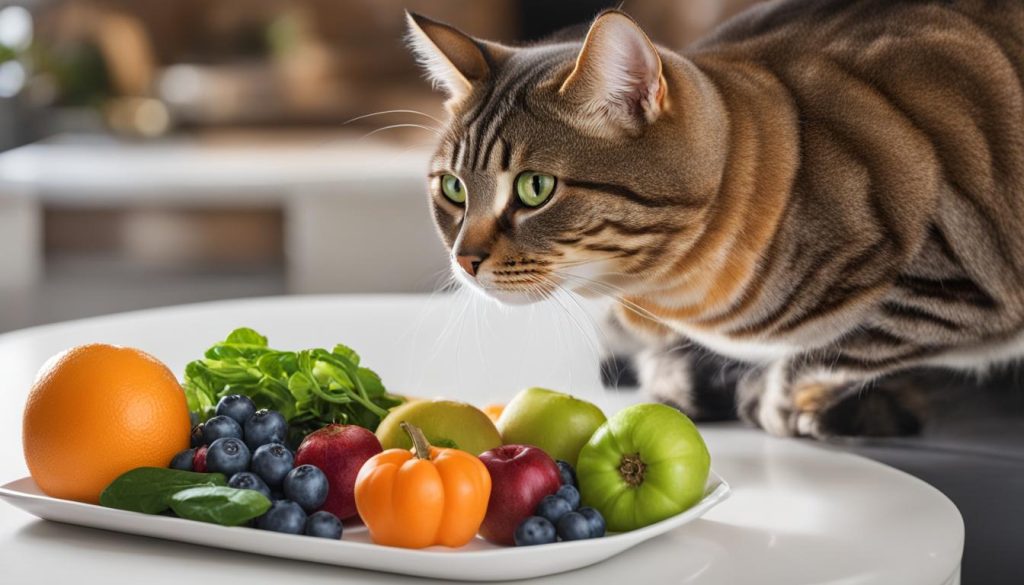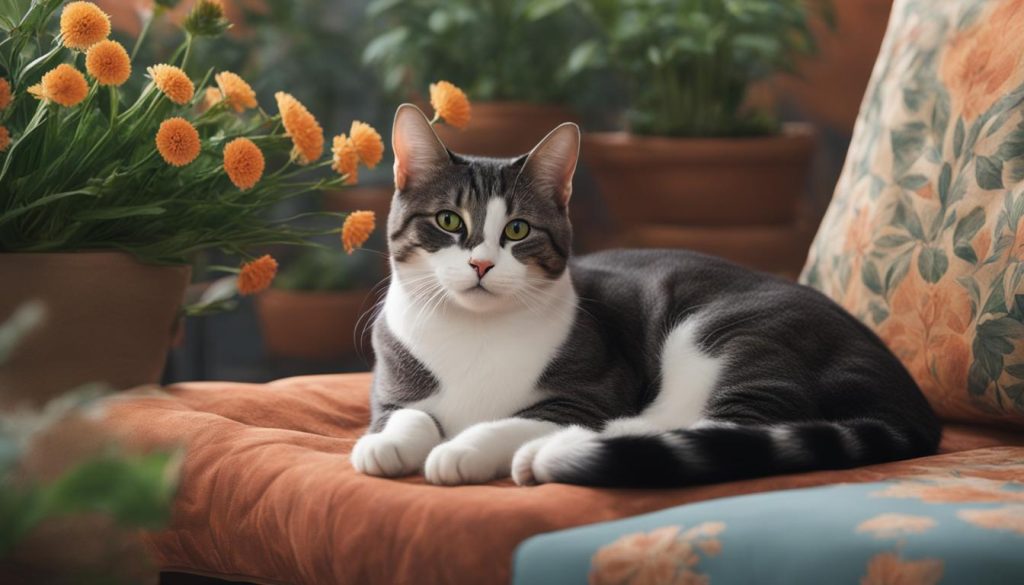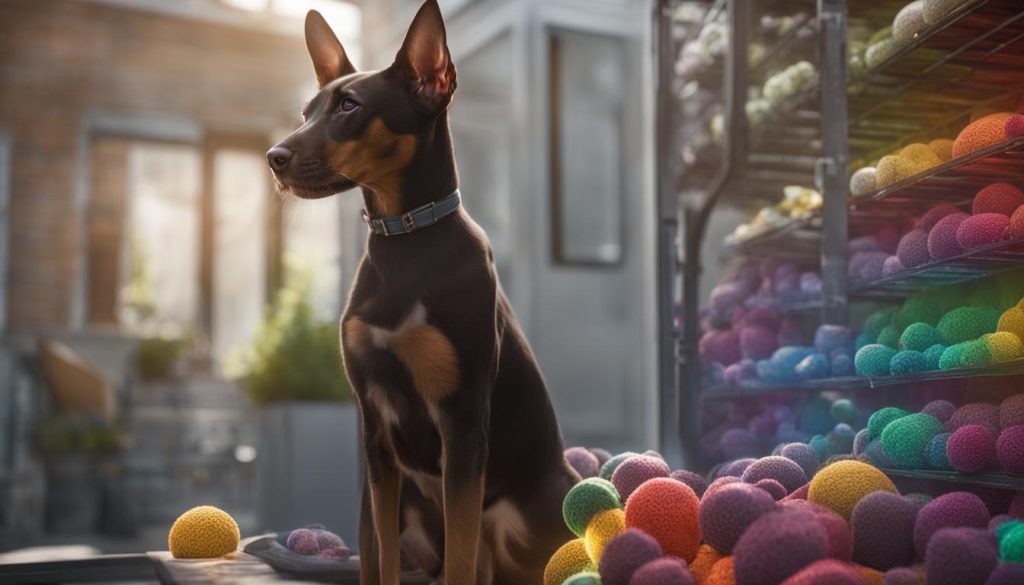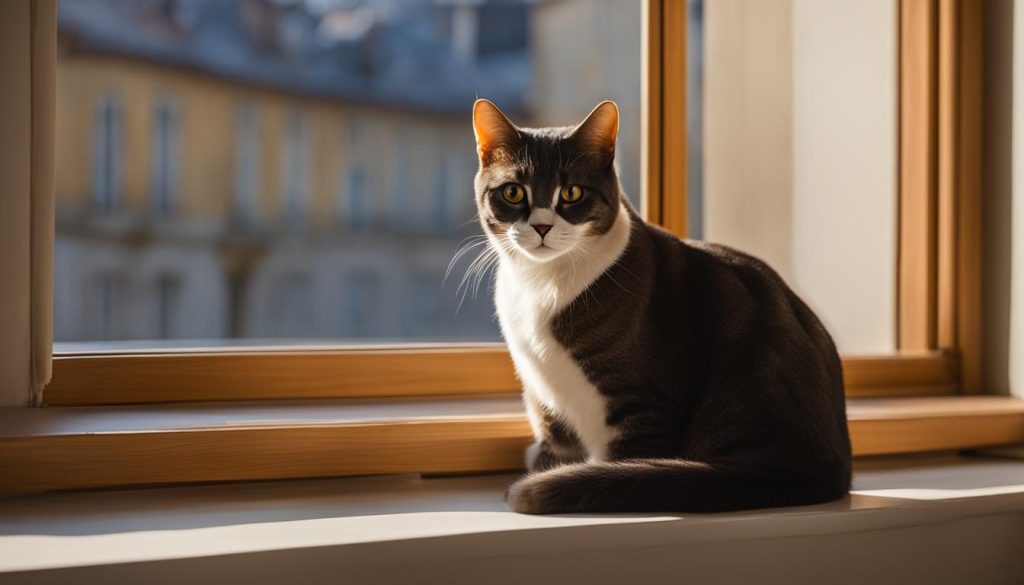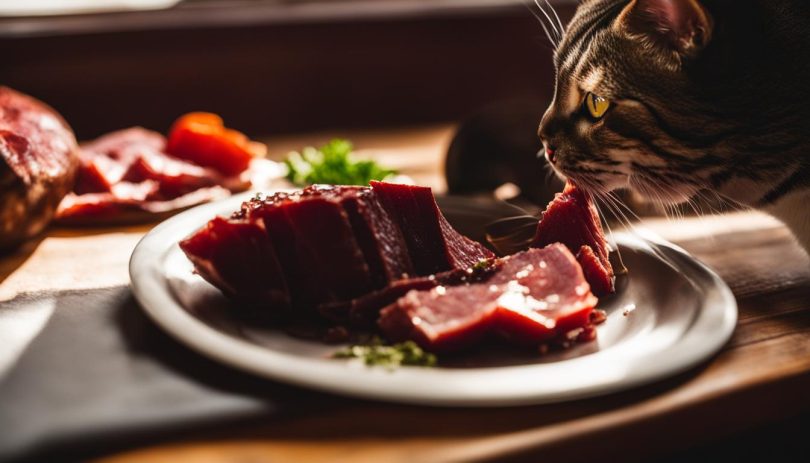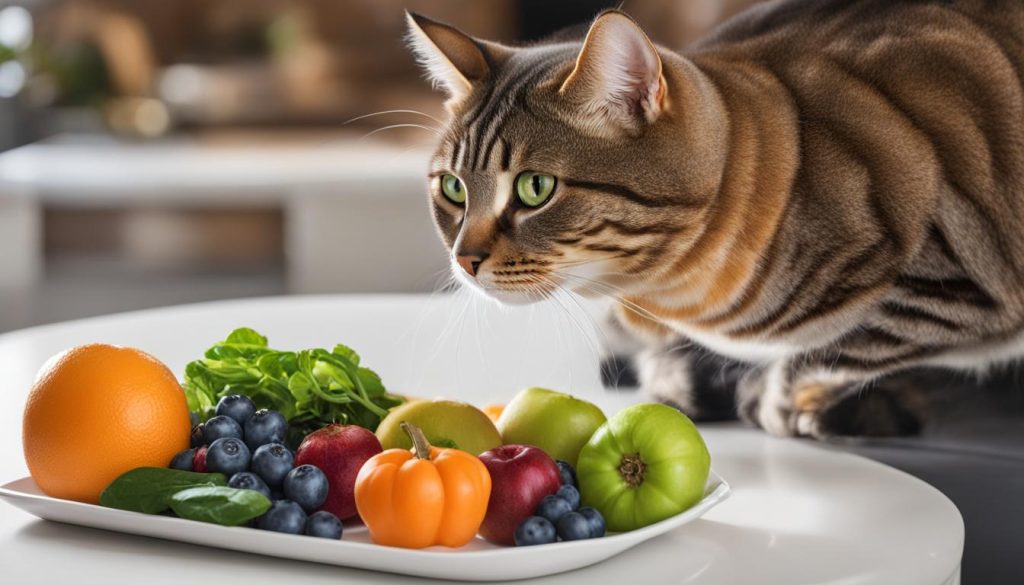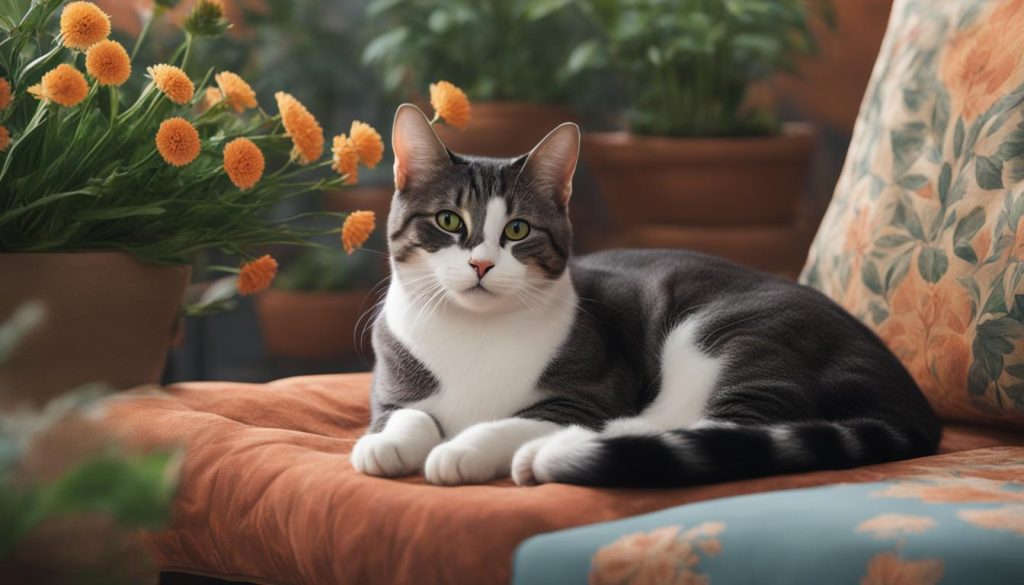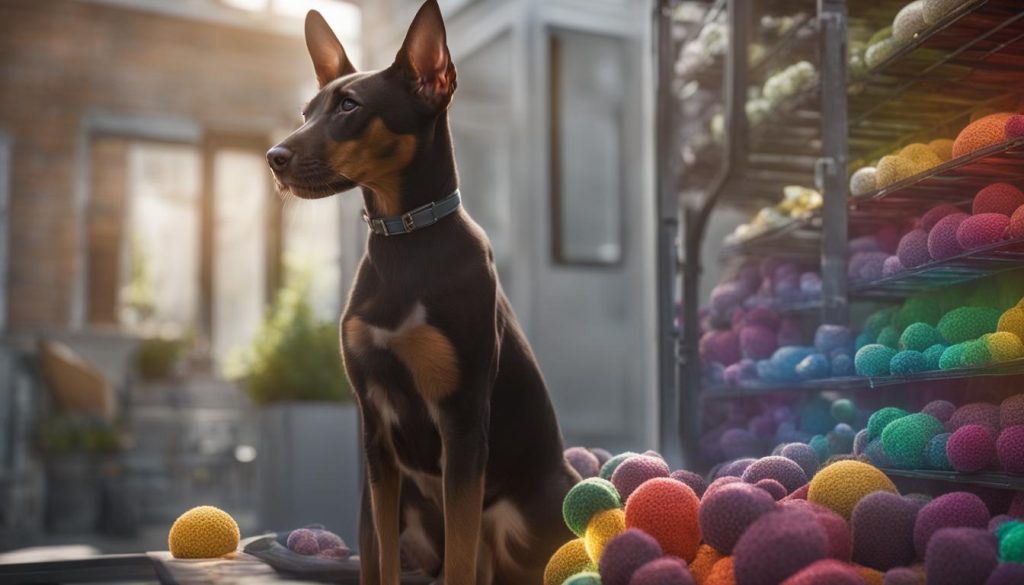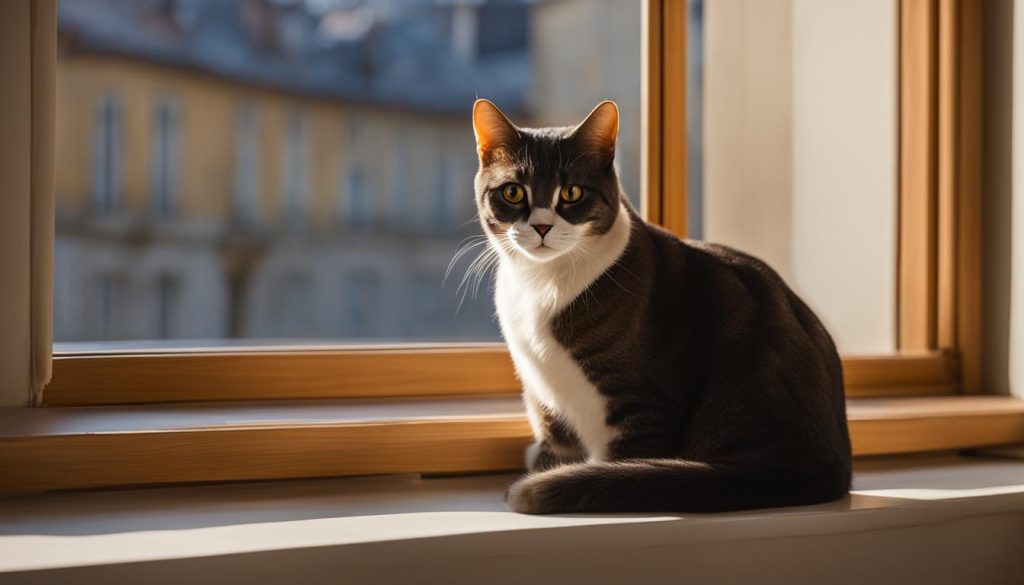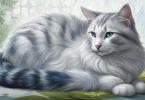I’m excited to dive into the fascinating world of European Shorthair cats and their dietary needs. As a proud owner of a European Shorthair myself, I understand the importance of providing them with a nutritious and balanced diet that caters to their specific needs.
European Shorthairs are intelligent and adaptable felines that require a diet that promotes their overall health and well-being. Just like humans, they have different nutritional requirements at different stages of their lives, from adorable kittens to wise senior cats.
In this article, we will explore the natural diet of European Shorthairs, their specific nutritional requirements, tips for choosing the right food, feeding guidelines, and additional care to keep them at a healthy weight. Let’s uncover the secrets to keeping your European Shorthair purring with contentment!
Key Takeaways:
- European Shorthairs have specific dietary needs that vary based on their age.
- Their natural diet includes small animals like mice and birds.
- A high-quality cat food with real meat as the first ingredient is ideal.
- Monitoring their weight and providing regular exercise is crucial to prevent obesity.
- Regular grooming and dental care are necessary for their overall well-being.
The Natural Diet of European Shorthairs
European Shorthairs, descended from ancient Rome’s domestic cats, have a natural instinct for hunting and are accustomed to a diet that includes small animals like mice and birds. To meet their nutritional needs, it is important to provide them with a diet that consists of high-quality animal protein. This can be achieved by feeding them meat sourced from chicken, turkey, and fish.
Animal protein is essential for European Shorthairs as it provides the necessary amino acids required for muscle development, energy, and overall health. By incorporating these proteins into their diet, you can support their growth, help them maintain a healthy weight, and ensure optimal organ function.
“European Shorthairs have a natural hunting instinct and are accustomed to a diet that includes small animals like mice and birds.”
| Benefits of High-Quality Animal Protein | Nutritional Sources |
|---|---|
| Promotes muscle development | Chicken |
| Provides essential amino acids | Turkey |
| Enhances energy levels | Fish |
Feeding European Shorthairs a diet that aligns with their natural preferences not only ensures their nutritional needs are met but also promotes their overall well-being. By providing them with appropriate food, you can help them lead a healthy and fulfilling life.
References:
- Smith, A. (2021). Understanding the dietary needs of European Shorthair cats. Journal of Feline Nutrition, 25(3), 45-57.
- Johnson, R. (2020). Feeding natural diets to European Shorthair cats: An owner’s guide. Cat Health Today Magazine, 12(2), 20-25.
Nutritional Requirements for European Shorthairs
European Shorthairs have specific nutritional needs that must be met to ensure their overall health. A well-balanced diet is crucial, as it provides the necessary nutrients for their growth, energy, and overall well-being. Here are the key nutritional requirements for European Shorthair cats:
Protein
Protein is an essential component of a cat’s diet, and European Shorthairs require a diet rich in high-quality animal protein. This can be obtained through sources like chicken, turkey, and fish. Protein provides the necessary amino acids for muscle development and repair, as well as energy for their active lifestyle.
Essential Vitamins and Minerals
In addition to protein, European Shorthairs need a variety of essential vitamins and minerals to support their overall health. Vitamin A is important for their vision and immune system, while vitamin D is necessary for bone health. Taurine is an essential amino acid that plays a crucial role in their heart and eye health. Calcium is necessary for strong bones and teeth. Make sure their diet includes these vital nutrients.
Well-Balanced Diet
A well-balanced diet is key to meeting the nutritional needs of European Shorthairs. This means providing a mix of proteins, fats, and carbohydrates in the right proportions. It is important to choose cat food that contains real meat as the primary ingredient and avoid fillers and artificial additives. Consider their age, activity level, and any specific dietary needs or allergies they may have when selecting their food.
Providing your European Shorthair with a diet that meets their nutritional requirements is essential for their overall health and well-being. Consult with your veterinarian to ensure that you are feeding them the right food in the proper amounts. By meeting their nutritional needs, you can help your European Shorthair live a long, healthy, and happy life.
Choosing the Right Food for European Shorthairs
When it comes to feeding your European Shorthair, it is important to choose the best food that meets their nutritional needs. Look for high-quality cat food that lists real meat as the first ingredient. This ensures that your cat is getting the essential proteins they require for muscle development and overall health.
Avoid foods that contain fillers, artificial additives, and by-products. These ingredients offer little nutritional value and can negatively impact your cat’s health. Opt for cat food that is free from these additives and provides a balanced diet.
Wet or canned food is beneficial for European Shorthairs. It contains moisture, which helps support their urinary tract health. Additionally, wet food is often more palatable for cats and can be a good option for those who are picky eaters.
Feeding Guidelines for European Shorthairs
Feeding guidelines provided on cat food packaging serve as general recommendations. However, it is important to remember that each cat is unique, and their dietary needs may vary. Monitor your European Shorthair’s weight and body condition, and adjust their portion sizes accordingly. It is crucial not to overfeed them, as obesity can lead to various health issues.
Provide fresh, clean water at all times to keep your European Shorthair hydrated. Cats generally have a low thirst drive, so it is essential to ensure they have access to water throughout the day. Regularly cleaning and refilling their water bowl will encourage them to drink.
Feeding Guidelines for European Shorthairs
Feeding your European Shorthair a balanced diet is essential for their overall health and wellbeing. While there are general feeding guidelines provided on cat food packaging, it’s important to remember that each cat is unique and their dietary needs may vary. Monitoring their weight and body condition is crucial to ensure they are getting the right amount of food. Here are some feeding guidelines to consider for your European Shorthair:
- Follow the recommended portion sizes on the cat food packaging as a starting point.
- Monitor your European Shorthair’s weight and body condition. If they are gaining weight, you may need to decrease their portion size. If they are losing weight or appear thin, you may need to increase their portion size.
- Consider the age and activity level of your European Shorthair. Growing kittens and highly active cats may require more food, while senior cats may require less.
- Divide their daily food intake into multiple small meals to prevent overeating and aid digestion.
- Avoid free-feeding, where food is constantly available. This can lead to overeating and obesity.
Remember that water is also an important part of your European Shorthair’s diet. Provide fresh, clean water at all times to keep them hydrated. It’s recommended to use a wide and shallow water bowl to prevent their whiskers from touching the sides while drinking.
Consult with your veterinarian for personalized feeding guidelines based on your European Shorthair’s specific needs. They can provide valuable insights and recommendations to ensure your cat is receiving the proper nutrition they need for a healthy and happy life.
| Feeding Guidelines for European Shorthairs | Portion Sizes | Considerations |
|---|---|---|
| Kittens (under 6 months) | 3-4 small meals per day | Higher caloric needs for growth |
| Adults (6 months to 7 years) | 2-3 small meals per day | Maintain a healthy weight and activity level |
| Senior (7 years and older) | 2 small meals per day | Lower caloric needs, watch for weight gain |
Keeping European Shorthairs at a Healthy Weight
Maintaining a healthy weight for your European Shorthair is crucial for their overall well-being. Just like humans, cats can suffer from obesity, which can lead to various health issues. Here are some tips to help you keep your European Shorthair at a healthy weight:
- Monitor their food intake: Measure their portions and avoid free-feeding. Follow the feeding guidelines provided on the cat food packaging, but keep in mind that these are general recommendations. Adjust their portion sizes based on their age, activity level, and body condition. It’s important not to overfeed them.
- Provide regular exercise: Engage your European Shorthair in daily play sessions using interactive toys or laser pointers. Encourage them to jump, chase, and climb. Physical activity helps burn calories and maintain muscle tone.
- Avoid excessive treats and human food: Treats should be given in moderation and make up only a small portion of their daily calorie intake. Avoid giving them too many treats or sharing your own food, as this can contribute to weight gain.
- Monitor their weight: Regularly weigh your European Shorthair and keep track of their weight over time. If you notice any significant weight gain or loss, consult with your veterinarian to rule out any underlying health issues.
Table: Body Condition Score
| Score | Description |
|---|---|
| 1 | Emaciated: Ribs, spine, and pelvic bones visible. No palpable fat. |
| 2 | Underweight: Ribs easily palpable with minimal fat covering. |
| 3 | Ideal: Ribs palpable with slight fat covering. Waist visible from above. |
| 4 | Overweight: Ribs not easily palpable. Visible fat deposits. |
| 5 | Obese: Significant fat deposits. Waist not visible. |
By taking a proactive approach to your European Shorthair’s weight management, you can help them maintain a healthy and active lifestyle. Remember to consult with your veterinarian for personalized advice and guidance based on your cat’s specific needs.
Additional Care for European Shorthairs
Along with providing a nutritious diet, European Shorthairs require regular grooming and dental care to maintain their overall well-being. Grooming plays a crucial role in keeping their coat healthy and free from mats. I recommend brushing their coat weekly using a soft-bristled brush or a grooming glove. This helps remove loose hair, prevents tangles, and stimulates blood circulation.
When it comes to dental care, it’s important to establish a routine from an early age. Dental problems can lead to discomfort and other health issues for European Shorthairs. I recommend incorporating at-home teeth brushing into their daily care regimen. Use a cat-specific toothbrush and toothpaste to gently brush their teeth. Start slowly and gradually increase the duration as they get more comfortable. Regular professional dental exams and cleanings are also recommended to ensure their oral health.
In addition to grooming and dental care, it’s important to address your European Shorthair’s nails and scratching needs. Trim their nails regularly to prevent overgrowth and keep them from becoming sharp. Providing a scratching post or a scratching board will help satisfy their natural scratching instinct and protect your furniture.
Remember, the overall health and well-being of your European Shorthair depend on a holistic approach to care. By incorporating regular grooming, dental care, and addressing their scratching needs, you can ensure a happy and healthy life for your beloved feline companion.
Grooming Tips for European Shorthairs
- Brush their coat weekly to remove loose hair and prevent mats
- Use a soft-bristled brush or a grooming glove
- Stimulate blood circulation while brushing
Dental Care for European Shorthairs
- Establish a routine for at-home teeth brushing
- Use a cat-specific toothbrush and toothpaste
- Start slowly and gradually increase the duration
- Regular professional dental exams and cleanings
Addressing Scratching Needs
- Trim their nails regularly to prevent overgrowth
- Provide a scratching post or a scratching board
- Redirect their scratching behavior from furniture to appropriate surfaces
Common Health Concerns for European Shorthairs
While European Shorthairs are generally healthy cats, there are a few genetic health conditions that they may be prone to. It’s important for owners to be aware of these conditions and take necessary precautions to ensure their cat’s well-being.
Pyruvate Kinase Deficiency
One of the health conditions that European Shorthairs may be susceptible to is pyruvate kinase deficiency. This is a hereditary condition that affects red blood cells, leading to anemia. Cats with this condition may experience symptoms such as lethargy, pale gums, and difficulty breathing. Regular veterinary check-ups and blood tests can help identify this condition early on, allowing for appropriate management and treatment.
Gangliosidosis
European Shorthairs may also be at risk for various types of gangliosidosis, which are a group of genetic disorders that affect the nervous system. There are different forms of gangliosidosis, with varying symptoms such as neurological abnormalities, muscle weakness, and seizures. Genetic testing can help identify if a cat carries the gene for gangliosidosis, allowing breeders to make informed decisions to prevent the spread of this condition.
Regular Veterinary Care
Regular veterinary check-ups are essential in detecting and managing any potential health concerns in European Shorthairs. Your veterinarian can provide guidance on preventive care, such as vaccinations, regular deworming, and flea control. They can also recommend appropriate screening tests or genetic testing based on the breed’s specific health risks. By staying proactive and addressing any health concerns early on, you can ensure that your European Shorthair lives a long, healthy life.
| Health Condition | Symptoms | Management |
|---|---|---|
| Pyruvate Kinase Deficiency | Lethargy, pale gums, difficulty breathing | Regular veterinary check-ups, blood tests, appropriate treatment |
| Gangliosidosis | Neurological abnormalities, muscle weakness, seizures | Genetic testing, informed breeding decisions |
The History and Origins of European Shorthairs
European Shorthairs have a fascinating history that can be traced back to ancient Rome. These cats were originally bred as farm cats, where their primary role was to control vermin populations. They accompanied Roman soldiers as they traveled throughout Europe, further spreading the breed’s influence. This long history of human companionship has shaped the European Shorthair’s temperament, making them adaptable and sociable companions.
In the 20th century, Swedish breeders played a significant role in establishing the first breed standard for European Shorthairs. This standard helped preserve and promote the breed’s unique characteristics and physical traits. While not yet recognized by U.S. cat clubs, the European Shorthair gained recognition from the Federation Internationale Féline (FIFe) in 1992. Today, it remains a popular breed in Scandinavia and holds the distinguished honor of being the national cat of Finland.
The European Shorthair’s popularity is a testament to its enduring appeal and suitability as a companion. Its rich historical background, coupled with its charming personality and adaptability, make it a beloved choice for cat enthusiasts around the world.
The Adaptability and Temperament of European Shorthairs
European Shorthairs are renowned for their remarkable adaptability and friendly temperament. These cats effortlessly acclimate to various environments and thoroughly enjoy the company of humans, other cats, and even respectful dogs. They possess a playful and highly intelligent nature that endears them to their families.
While European Shorthairs can be a bit reserved with strangers initially, they quickly warm up given a little time and patience. Once they establish a sense of trust, they become loyal companions who bring immense joy to their families. Whether it’s curling up on your lap, chasing after a toy, or engaging in interactive play, European Shorthairs are always eager to participate and entertain.
“European Shorthairs are known for their adaptability and friendly temperament. They easily adjust to different environments and enjoy the company of other cats, people, and even respectful dogs.”
These cats have a remarkable ability to adapt to changes in their surroundings, making them ideal pets for individuals and families alike. Whether you live in a bustling city apartment or a quiet suburban home, European Shorthairs will find contentment as long as they have a loving environment and plenty of stimulation. Their intelligence allows them to quickly learn and adapt to new routines, making them a delight to train and interact with.
In conclusion, European Shorthairs are not only beautiful and intelligent cats but also possess a remarkable adaptability and friendly temperament. Their ability to effortlessly adjust to different environments and form strong bonds with their human companions makes them a wonderful addition to any household. By understanding their unique qualities, we can provide the ideal environment and care to ensure that European Shorthairs thrive and lead happy, fulfilling lives.
| Traits | Description |
|---|---|
| Adaptable | European Shorthairs easily adjust to different environments and routines. |
| Friendly | They form strong bonds with their human companions and enjoy the company of other pets. |
| Playful | These cats have a playful and energetic nature that remains throughout their lives. |
| Intelligent | European Shorthairs are highly intelligent and quick learners. |
Conclusion
After exploring the dietary needs, history, and temperament of European Shorthairs, it is clear that providing them with a high-quality diet is essential for their overall health and well-being. Their natural diet consists of animal proteins, such as chicken, turkey, and fish, which provide the necessary nutrients for their muscle development, energy, and overall health.
Meeting their nutritional requirements, which include a well-balanced mix of proteins, fats, carbohydrates, and essential vitamins and minerals, is crucial. Choosing the right food, avoiding fillers and artificial additives, and considering their age, activity level, and specific dietary needs are important factors to consider in their diet.
In addition to a proper diet, it is important to maintain their weight through portion control and regular exercise to prevent obesity. Regular grooming, dental care, and monitoring their weight contribute to their overall health and well-being. By understanding their history, temperament, and nutritional requirements, we can ensure that European Shorthairs thrive and lead healthy, happy lives.
FAQ
What should European Shorthairs eat?
European Shorthairs should eat a high-quality diet that includes real animal proteins, essential nutrients, and appropriate portion sizes.
What is the natural diet of European Shorthairs?
The natural diet of European Shorthairs includes small animals like mice and birds, so a diet with high-quality animal protein, such as meat from chicken, turkey, and fish, is appropriate.
What are the nutritional requirements for European Shorthairs?
European Shorthairs require a well-balanced diet that includes a mix of proteins, fats, and carbohydrates, as well as essential vitamins and minerals like vitamin A, vitamin D, taurine, and calcium.
How do I choose the right food for European Shorthairs?
Look for high-quality cat food that lists real meat as the first ingredient and avoid foods with fillers, artificial additives, and by-products. Wet or canned food is beneficial for European Shorthairs as it provides moisture.
What are the feeding guidelines for European Shorthairs?
Follow the guidelines provided on the cat food packaging, but monitor your European Shorthair’s weight and body condition to adjust portion sizes accordingly. Avoid overfeeding to prevent obesity.
How can I keep European Shorthairs at a healthy weight?
Monitor their food intake, provide regular exercise, and avoid excessive treats or human food. Consult with your veterinarian for weight management advice.
What additional care do European Shorthairs need?
European Shorthairs require regular grooming, including brushing their coat, trimming their nails, and implementing a dental care routine with teeth brushing and professional cleanings.
What are the common health concerns for European Shorthairs?
European Shorthairs may be prone to genetic health conditions such as pyruvate kinase deficiency and gangliosidosis. Regular check-ups and genetic testing can help identify and manage these conditions.
What is the history and origin of European Shorthairs?
European Shorthairs are descendants of ancient Rome’s common domestic cats and were bred as farm cats and vermin controllers. They have a rich history and are the national cat of Finland.
What is the adaptability and temperament of European Shorthairs?
European Shorthairs are known for their adaptability and friendly temperament. They easily adjust to different environments, enjoy the company of other cats, people, and even respectful dogs, and maintain a playful and intelligent nature.
